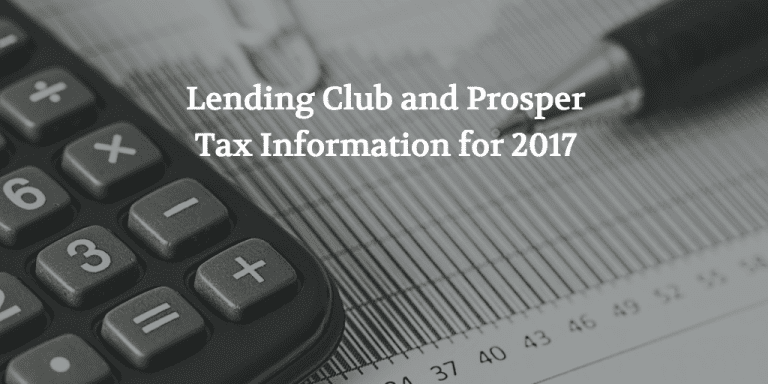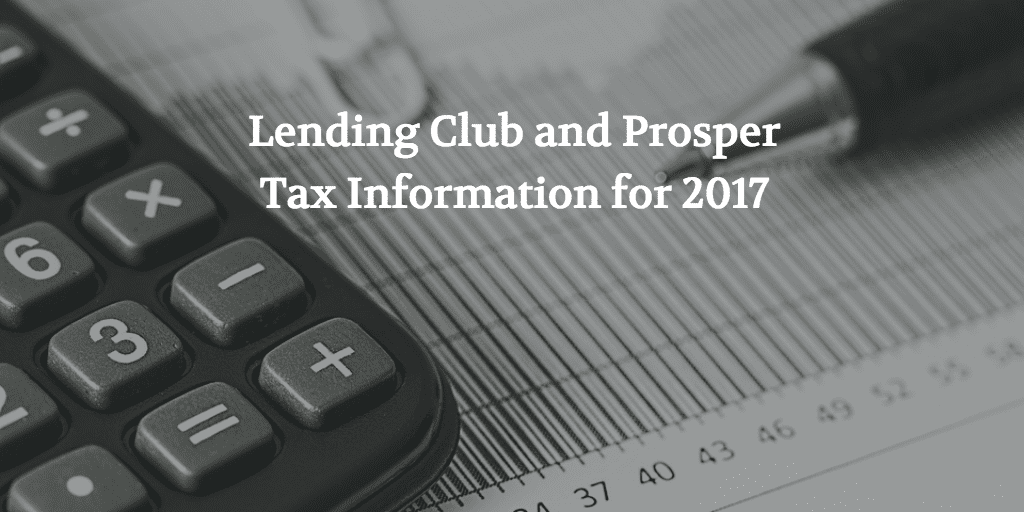
[Disclaimer: I am not an accountant nor am I qualified to provide tax advice. This post shares how Lending Club and Prosper are presenting their tax information this year. You should seek professional advice before taking action on any of the ideas presented here.]
Every year we share what investors can expect when filing their taxes if they invested in Lending Club or Prosper loans. Below I share some helpful tax resources from each company, my account performance from 2016 and the tax inefficiency investing through a taxable account.
Filing Taxes on Lending Club Loans
Similar to last year, Lending Club has made the process easy if you use TurboTax to file your taxes. They have dedicated part of the help section of their website to outline the step by step process of how to accomplish the import. If you’re not a TurboTax customer, Lending Club has provided a 2016 update to their Tax Guide for Retail Investors. Your tax documents for 2016 can be found under the “Statements” section of your account under tax statements. The consolidated PDF you receive will include various sections as outlined below depending on your account. Most investors will receive just a 1099-OID and 1099-B unless you sold notes on the secondary market. For investors who started investing in late 2016 it is possible you won’t have any losses which means you won’t receive a 1099-B for recoveries and proceeds from charged-off loans.
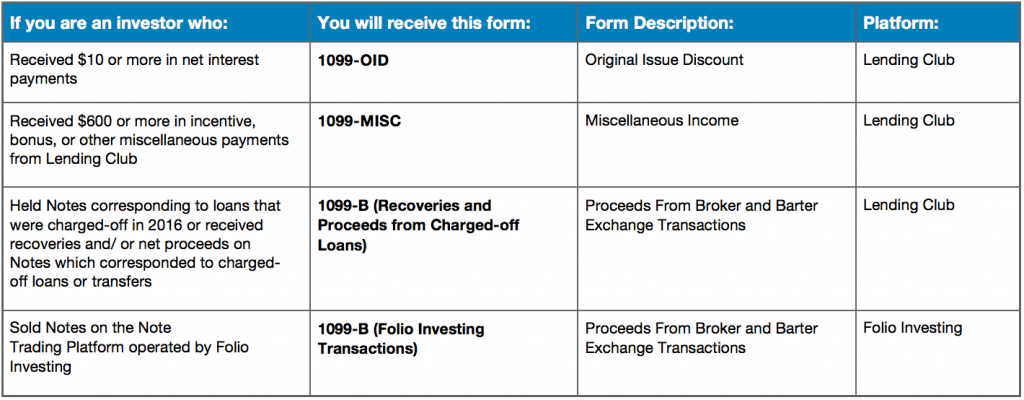
In my case I received a 1099-OID and 1099-B. My 1099-OID shown below shows the interest I received from Lending Club notes.

My 1099-B shows proceeds of $151.17. This is the total amount of proceeds I received from charged off loans. The “Cost or Other Basis” is the cost basis for the loans that have charged off. If you take any proceeds and subtract it from the basis you calculate the losses which is broken down by loan in the tax statement and also totaled at the bottom. In my case I had $366.62 short term losses and $980.52 long term losses totaling $1,347.14 in total losses for the year.
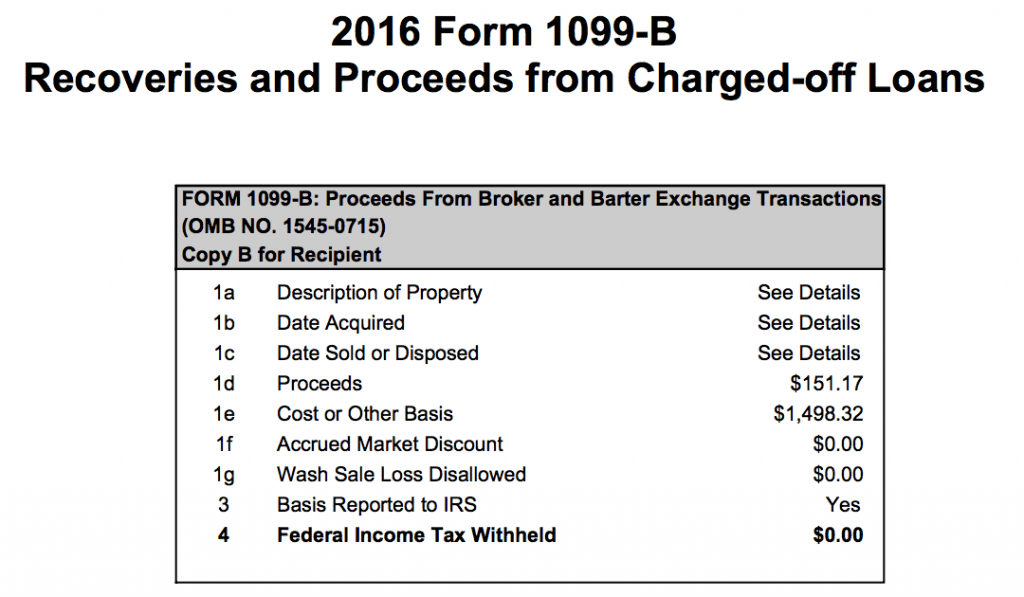
The tax guide provided by Lending Club shows clearly where these figures should be reflected on the tax documents you file. The image below shows where your interest should be reported on Form 1040.
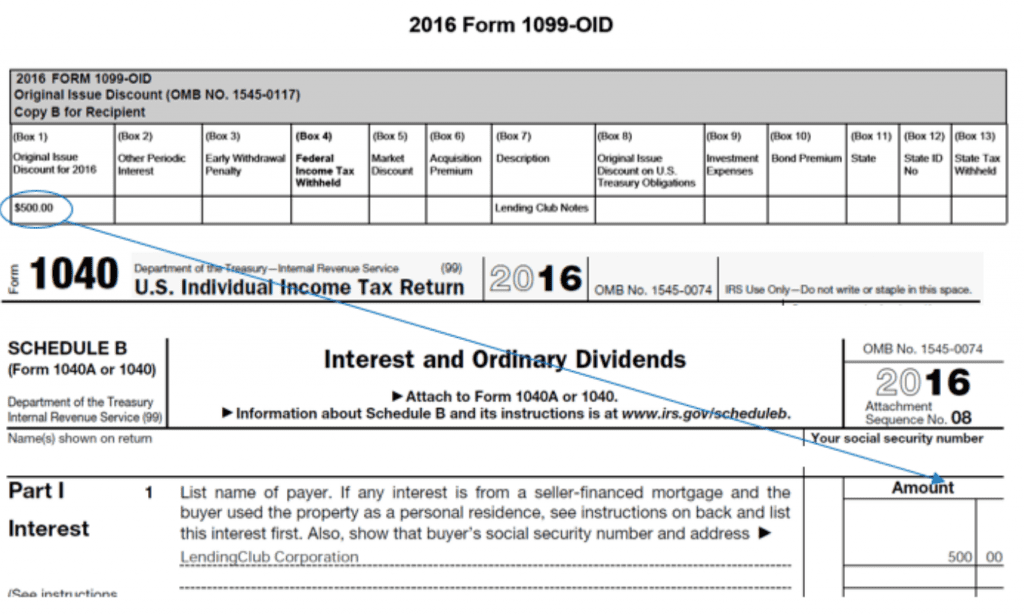
While we aren’t qualified to give tax advice, many investors list “Various” on the 8949 tax form when reporting recoveries and proceeds on charged-off loans instead of listing out each individual loan. Below is an example of short-term transaction reporting. You can find more examples in the tax guide.
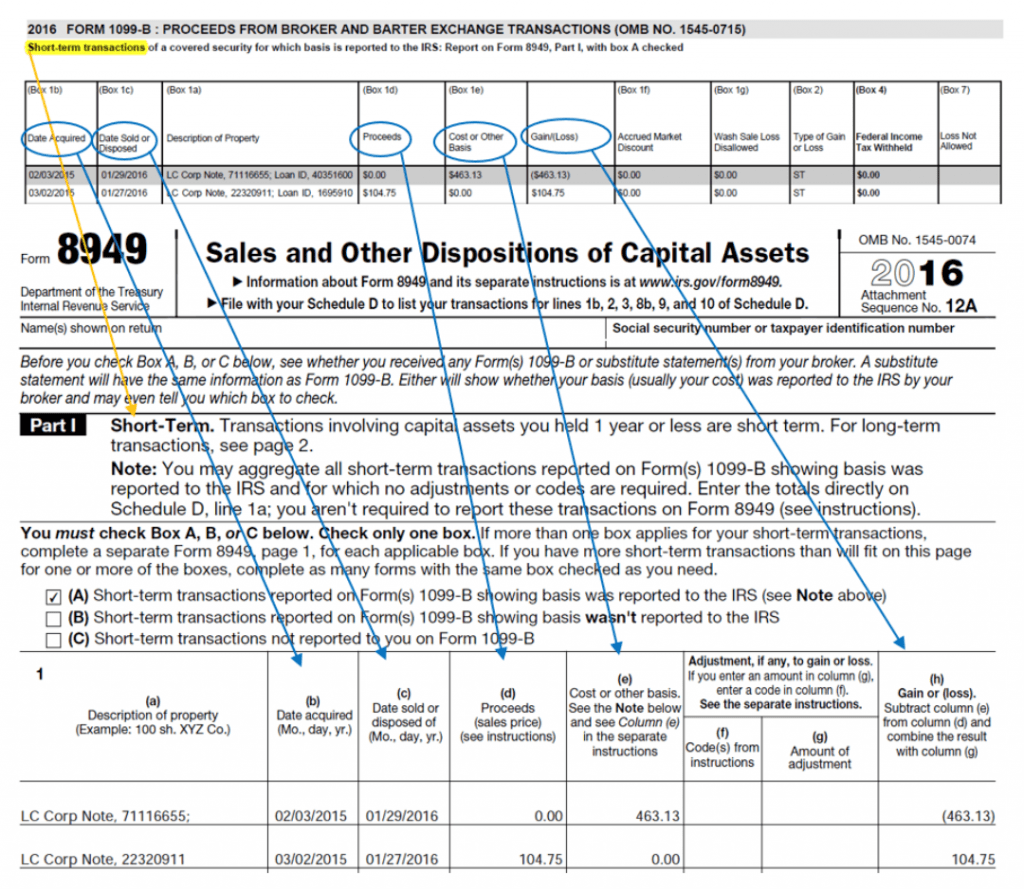
There are two additional things worth pointing out from Lending Club’s tax guide to help you better understand how the cost basis is reported (important if you transact on the secondary market) and how gains/losses are generally reported.
Note on Tax Cost Basis
Please keep in mind that Notes purchased on the Folio Investing Note Trading Platform may have been purchased at a discount or premium relative to outstanding principal plus accrued interest at the time of purchase, and additional information is provided in order to help you determine the cost basis for transactions involving these Notes. However, investors are ultimately responsible for tracking their tax cost basis. The basis reported on Form 1099 may differ materially from an investor’s tax cost basis, depending on the investor’s personal tax situation. For more information, please consult your financial or tax advisor.
Note on Gains / Losses
Generally, gains and losses from recoveries, sales or charge-offs related to Lending Club Notes are reported for tax purposes as capital gains or losses, rather than ordinary gains or losses. Generally, Lending Club Notes are considered capital assets because they are owned for the purposes of investment (similar to a stock or a bond).
Generally, realized capital losses are first offset against realized capital gains. For individuals, any excess capital losses can be deducted against ordinary income up to $3,000 ($1,500 if married filing separately). Capital losses in excess of this limit may be carried forward to later years to reduce capital gains or ordinary income until the capital losses are fully utilized.
Filing Taxes on Prosper Loans
Filing your taxes if you’re an investor on Prosper is similar to that of Lending Club. Your Prosper tax documents can be found by clicking on “History” under your name. Next, click “Statements”. Prosper provides each document separately instead of a consolidated report. In my case I received a 1099-OID and two 1099-B documents (one for short term and one for long term). Prosper breaks down what documents you will receive on the help section of their website. They also provide other FAQs on filing your taxes.
1099-OID
You will be provided a Form 1099-OID in any tax year that you have interest income on Notes originated in 2009 or later. Income shown on Form 1099-OID will be reported to the Internal Revenue Service and State tax authorities in the event applicable thresholds established by them are met. This form details income reported on Notes that are subject to OID tax reporting. See Questions Related to OID Tax Reporting below.
1099-B
If you sold Notes on the Folio Investing Note Trader platform during the tax year, you will be provided a Form 1099-B from FOLIOfn that shows your sale date, proceeds, and cost basis, broken down into short and long term gains. You will receive a Form 1099-B from Prosper for any Notes that were charged off.
1099-MISC
You will be provided a Form 1099-MISC in each tax year that you receive borrower late fees, referral awards, bonuses, incentives, and so forth. Income shown on Form 1099-MISC will be reported to the Internal Revenue Service and State tax authorities in the event applicable thresholds as established by them are met.
My 1099-OID outlined the interest received of $1,226.42 and below that is my 1099-B outlining proceeds and losses from charged off loans. Although these documents look different than the ones Lending Club provides, the information and how it should be reported on your taxes is the same.
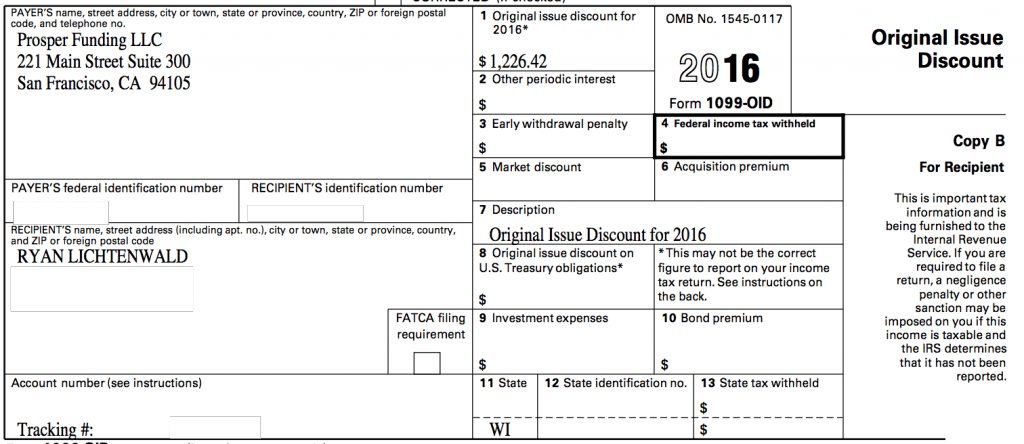
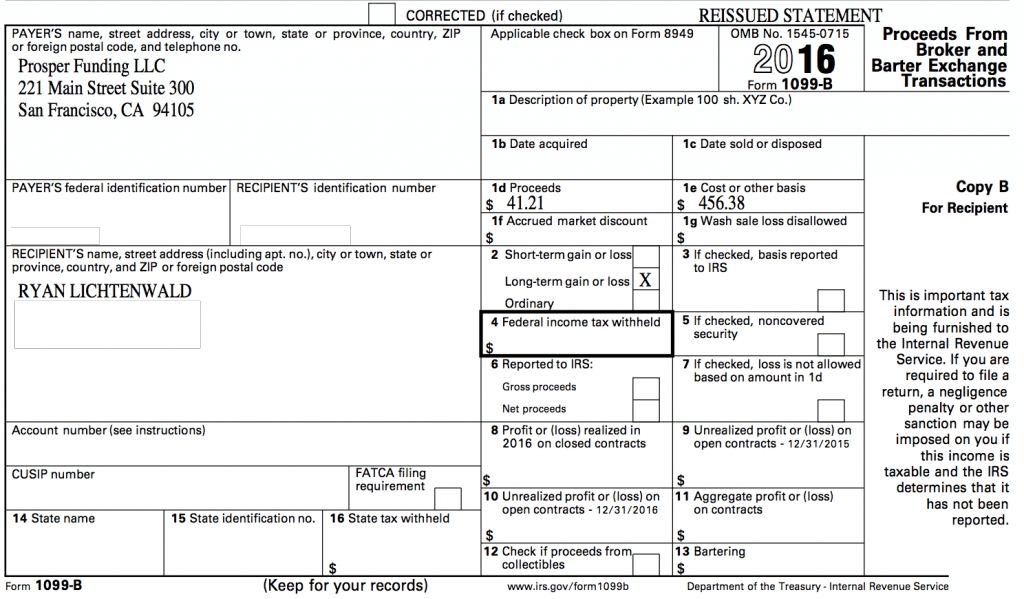
A Note on Tax Efficiency
Since it is tax time many investors use this time to reevaluate investments and asset allocation. We have highlighted this before, but it’s important to remember that the tax treatment on Lending Club and Prosper investments are less efficient compared to other non-fixed income asset classes such as stocks. This is due to the fact that income earned from p2p lending investments is treated as ordinary income.
In addition the maximum capital losses you can deduct is $3,000 for a year (Federal) and any amount over that will be carried forward to future years. On the state level this will depend on where you live. For instance, where I live in Wisconsin there is a $500 limit on the Wisconsin deduction for capital losses. While I remained below the $3,000 federal limit, I now am carrying over losses on the state level year after year since I invest through a taxable account.
Capital losses first offset capital gains. With no capital gains, the losses will be deducted from ordinary income. Depending on your ordinary income tax rate, this means that your capital losses may be offset first by long-term gains that have more favorable tax treatment, usually 15% (depending on your income), as opposed to your potentially higher ordinary income tax rate. Short-term gains on the other hand have a higher tax rate, similar to the ordinary income tax rates (see Capital gains tax in the U.S.).
While each situation is unique it’s worth considering holding your p2p lending investments in a traditional IRA or Roth IRA.


